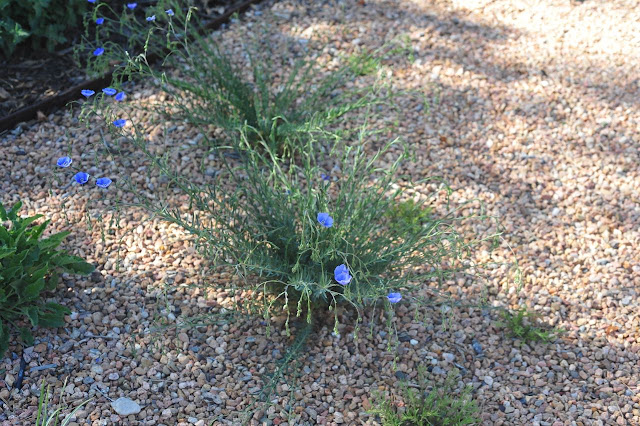There are two main types of lavender grown here in the high desert. What is most commonly referred to when people say "lavender" is
Lavandula angustifolia, also known as "English Lavender" or "True Lavender". I think that the term "English Lavender" is because this is the form that is most commonly grown in the UK, but it isn't actually native to that region. "True Lavender"is a funny name to me, but it is called that because when Lavenders were first named, what is now known as
L. angustifolia was also lumped with what is now known
L. latifolia, and was called
L. spica. "True Lavender" was renamed
L. officinalis denoting it's medicinal use. It was later renamed
L. vera, and now is known as
L. angustifolia. I don't really like either of the common names, but I tend to use "English Lavender" since two other lavenders are "Spanish Lavender" (
L. stoechas) and "French Lavender" (
L. dentata). Spanish Lavender is occasionally to rarely grown here, and French Lavender is not hardy in this area so can only be grown as an annual. The other lavender that is commonly grown here is known as "lavandin". Lavandin is a hybrid between
L. angustifolia and
L. latifolia, and is botanically
Lavandula x intermedia.
Now the reason I point all this out is because when I started growing lavenders, I didn't know the difference. All I could find is hat the lavandins grow larger, are sterile, have very long stems good for craft work, and that lavandins are described as what is grown in the french perfume fields. I knew I had to have that one. I grew both 'Provence' and 'Grosso', both of which are highly perfumed, although the darker color of 'Grosso' makes it stand out in the landscape more.
 |
| 'Provence' (left) and 'Grosso' (right). Note the long stems. |
I struggled with pruning them those years, because they grow from the branch tips, and while I pruned them back as far as I could see any live growth, the plants became larger and larger each year, until they were five to six feet across, and then tended to die out in sections leaving a very unattractive mess of bare branches and tufts of growth at the ends. The only option was to replace them. Pruning back hard to the base results in dead stumps that do not regrow.
I then moved to this house
which has what I believe is 'Hidcote', an English lavender, and learned how differently the English lavenders grow. English lavenders grow at the ends of the branches, but only until they get to a certain predetermined height. Then those branches die back in the winter and the plants grow new branches from the base. Because of this, all the dead branches need to be removed, to allow the new growth to come in. What it also means, and this is the important thing for a garden, is that the plants tend to stay the same size. When pruned back to the basal growths, those growths will achieve about the same size plant as the last year by blooming time.
 |
| English lavender 'Vicenza Blue'. Yep, an Italian English lavender. Note the short stems. |
Yesterday when I was pruning my lavender, I was noticing not only the the fragrance is indeed sweeter than the more camphorous lavandins, but the way they are pruned are totally different.
Here is my English lavender yesterday before pruning. You can see that the new growth is at the base. For lavandins, the growth would be at the ends.
After pruning half of it, you can see the the new growth more clearly.
The end result.
This 'Provence' lavandin had gotten too large for the spot. I tried cutting it back hard last spring, and you can see the result.
There was a tiny twig on the right that was near the base, and that is the only part that survived. The entire plant to the left did not regrow, and you can see the many dead stumps. (By the way, in a climate any more humid or moist than this one, don't mulch your lavenders or they will rot. Here, the mulch is needed to keep in moisture.)
Closer up, you can see the difference. You can see that the growth is only at the last couple of inches where there are green leaves. Further down, there is no active new growths from the leave nodes, and they won't grow them if you cut back below the new growths. You can also see how the lavandins die back - a large chunk of branch at a time, leaving a bare section in what would be a mound.
So although there are benefits to each, keep in mind the growth habits and care of each, in addition to the floral qualities. English lavender (
L. angustifolia): short stems, smaller plants, sweeter fragrance, longer plant life. Lavandin (
L. x intermedia): long stems, larger plants (each year larger), shorter plant life.


























































